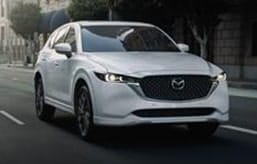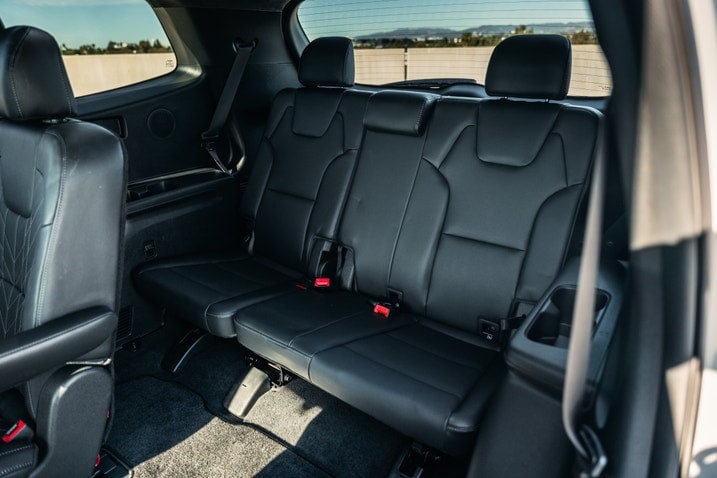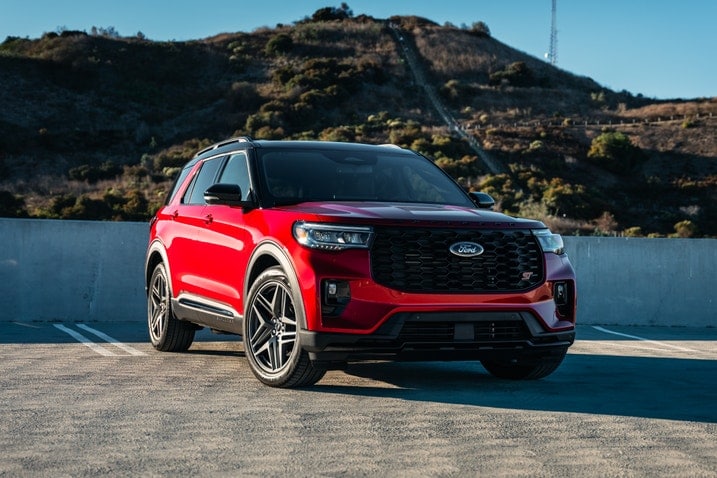- The Ford Explorer got a big update for 2025 that fixes some of the SUV's big issues.
- So, we put went up against two midsize three-row mainstays: the Honda Pilot and Kia Telluride.
- Over the course of five categories, we'll discuss the pros and cons of each, but there's one clear winner.
Ford Explorer vs. Honda Pilot vs. Kia Telluride: Which 3-Row SUV Is Right for You?
The 2025 Ford Explorer tries to catch up to the pack
Midsize three-row SUVs represent one of the most hotly contested automotive battlegrounds, as nearly every mainstream automaker offers a vehicle in this size and price range. And with one of the three-row mainstays — the Ford Explorer — having recently been overhauled, we thought it best to bring in a few of the segment's best to see if the Blue Oval's stalwart SUV can move up in the rankings hierarchy.
Joining the Explorer for this showdown are the Honda Pilot, a family-friendly three-row mainstay, and the Kia Telluride, an SUV that's been the king of this segment since its introduction in 2020. There's a lot to consider when it comes to three-row SUVs and lots of competing priorities, so to help you find the one that will best fit your needs, we'll compare these vehicles across the following categories: interior/comfort, technology, cargo/storage, driving dynamics and overall value. Let's see how they stack up.
Interior/comfort
Before its update, the Explorer suffered from two major weaknesses: Its interior didn't match the SUV's price tag and there was a major lack of passenger room, especially in the third row. One of those issues has been addressed — the Explorer's upgraded materials make the SUV feel more premium. But the third row is still cramped and has less space than what you get in the Pilot or Telluride.
However, the Pilot's interior doesn't feel all that modern. The styling is a black hole, and we highly recommend getting a lighter upholstery color. But where this SUV excels is seating flexibility; it's the only vehicle in our test to offer seating for seven or eight passengers thanks to a removable second-row center seat that can easily be lifted out and stored in a bin in the cargo area. Overall, the Pilot has a lot of passenger room — certainly more than the Ford.
The Telluride has the least amount of third-row legroom on paper, but thanks to the generous travel afforded by the second-row captain's chairs, more comfortable seats and a good place to put your feet, it's our favorite way-back by far. The Kia's attractive interior also has the most comfortable thrones up front, with great padding and support. The Kia also has the advantage when it comes to overall quality and use of materials. This is the closest you'll get to a luxury interior in this bunch.
Technology
This is where the Ford strikes back. Higher trims of the Explorer previously offered a vertically oriented 10.1-inch touchscreen, but the newly standard 13.2-inch horizontal touchscreen is a massive improvement. The brand-new infotainment system integrates Google applications, so Google Maps is now your native navigation setup and there's access to the Google Play store so you can download things like Spotify or games. Ford still provides the option of wireless Android Auto or Apple CarPlay if that's your preference.
On top of that, the Explorer is the only vehicle in this test to offer a hands-free driving system: an updated version of BlueCruise. It remains in hands-free mode more consistently and does a much better job of lane centering than it used to. BlueCruise can be purchased for $2,495 up front, or through a $495 annual subscription.
The Pilot's 9-inch screen is dinky compared to what you get in the other two SUVs, and it also isn't running Honda's latest infotainment tech, so the native maps application looks and feels outdated. Thankfully there's wireless Android Auto and Apple CarPlay to help things along. The Pilot's driving aids are less refined; the lane keeping system isn't as good as Ford's or Kia's. And the surround-view camera system is weirdly low-resolution with distorted views, a far cry from the great cameras you're getting in the other two SUVs.
In the Telluride, you get a pair of 12.3-inch screens for the gauge cluster and multimedia system, and its driver aids work seamlessly. But the Kia lacks wireless functionality for Android Auto and Apple CarPlay, and on top of that, its data port is USB-A and not a newer USB-C so you'll have to dig one of those cables out of the desk drawer.
Cargo and storage
Each of these SUVs has similar cargo room behind their first and second rows, between 85.3 and 87.0 cubic feet. But behind the third rows, some differences emerge. The Telluride offers the most room behind the third row with 21.0 cubic feet, compared to the Pilot's 18.6 cubic feet and the Ford's 16.3 cubes. However, the Pilot has an enormous underfloor storage bin to fit that removable center seat, and if you decide to leave the seat installed, or just keep it at home, you get a very nice secured storage space. On top of that, the Pilot's cargo floor can be removed and turned over to reveal a hard plastic surface, so if you're putting anything dirty back there, you don't have to ruin the carpet and you can just hose off the plastic instead.
The Pilot is also the best when it comes to small-item storage, with some large cupholders that can fit giant water bottles, and it's the best for installing car seats, with the Kia closely behind. We like the Explorer's new shelf under its screen that offers a great place to keep your phone or a pair of sunglasses, but it's the toughest SUV in which to install car seats.
Driving
The Explorer is the best of these vehicles to drive and it's not even close. Granted, our test vehicle is the high-performance ST, which makes 400 horsepower from a 3.0-liter twin-turbo V6, which is significantly more oomph than what you get in the naturally aspirated V6 engines from Honda (285 hp) or Kia (291 hp). But even without this optional engine, the base, turbocharged four-cylinder engine the Explorer is also better than its rivals' V6 options. No matter what's under the hood, the Explorer simply feels more alive from behind the wheel.
While the Honda and the Kia can't compete on fun, they both offer nicely composed rides and enough power to make passing on the highway or merging easy tasks. We do like the Kia's transmission more than the Honda, which gets a bit lurchy at low speeds as it hunts for gears. And the Kia is whisper-quiet at highway speeds, making it feel more refined than the Explorer or Pilot.
Value
The Explorer's big engine means it has a big price tag, and all of our vehicles for this comparison are equipped with all-wheel drive and are just about fully loaded. The as-tested prices for these three vehicles showed a large discrepancy, with the Explorer ST coming in at $66,396, the Pilot Black Edition following at $56,130 and the Telluride SX Prestige X-Line costing $54,540.
The Explorer is offered in a lower ST-Line grade with the base engine and many of the same features and appearance upgrades for around $53,000, which would bring it more in line with the other two vehicles in this comparison. And it's also much more palatable with the nearly $5,000 black painted roof option unchecked.
If you were to sit in the Kia and Honda back to back, you'd be shocked to find out that the Pilot is the more expensive of the two given the Kia's edge in material quality and overall aesthetics. The Pilot's interior feels solidly built, but it's plasticky and utilitarian compared to the Telluride. And neither the Ford nor Honda can compete with Kia's outstanding 10-year/100,000-mile powertrain warranty.
Fuel economy is a wash, as none of these vehicles will offer great efficiency; the Explorer ST, Pilot Black Edition and Telluride SX X-Line are EPA-estimated to achieve 20 mpg, 21 mpg and 20 mpg, respectively. If efficiency is a priority for you, there are some good hybrid options available from other companies, including the Hyundai Santa Fe Hybrid and the Toyota Grand Highlander Hybrid.
Overall winner: Kia Telluride
While the Explorer makes a valiant effort and the 2025 model-year improvements bump its Edmunds Rating up from a 7.7 to an 8.1, it still isn't enough to dethrone the Telluride as the benchmark in this class. We still find the Telluride's all-around appeal and its great value to be formidable, especially given the Explorer's space constraints. But if having the latest technology and the best driving experience are paramount to you, we think you'll still be plenty happy in the Ford, so it earns second place in this test. Even though the Pilot comes in third place, its family-friendly interior and generous cargo area make it a strong contender as well, especially for those with young children or who will need maximum flexibility when it comes to seating arrangements.
Photos by Ryan Greger









 by
by  edited by
edited by